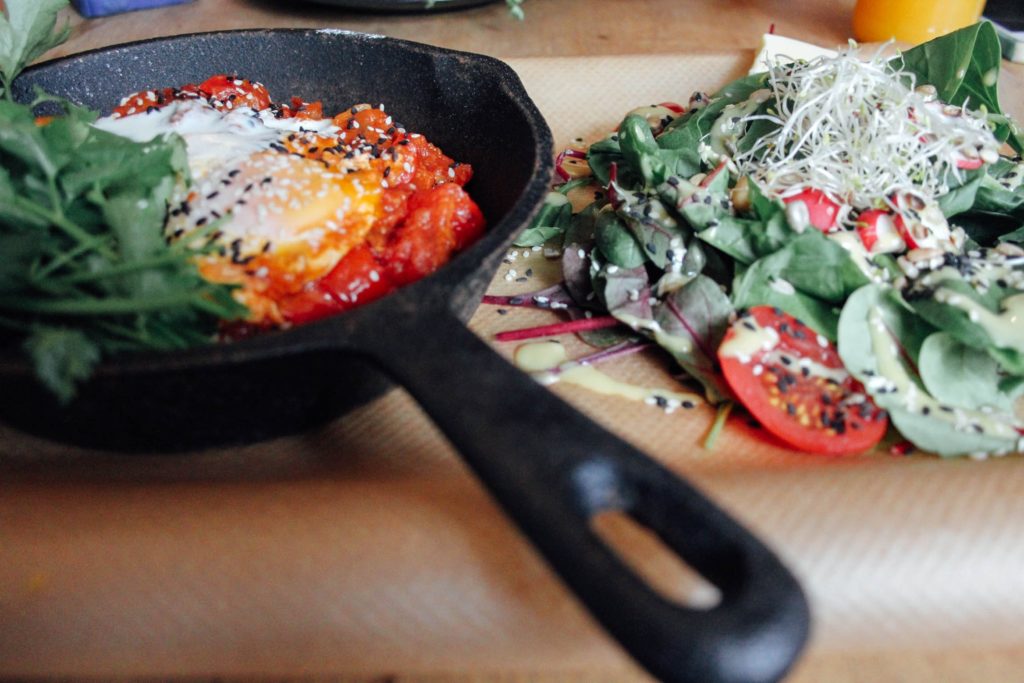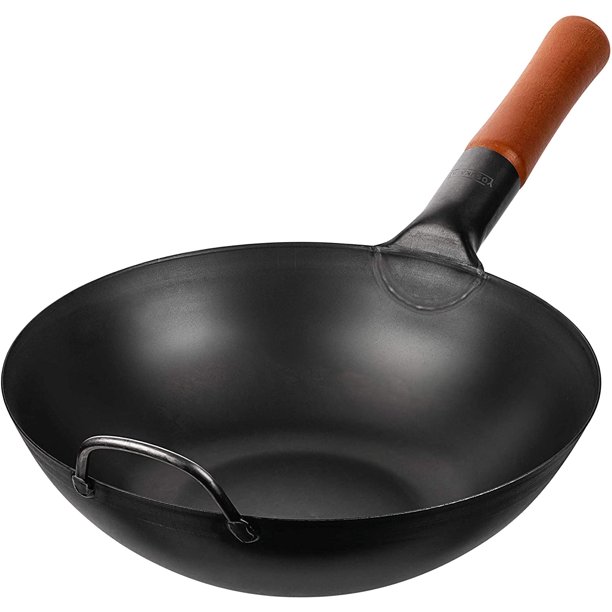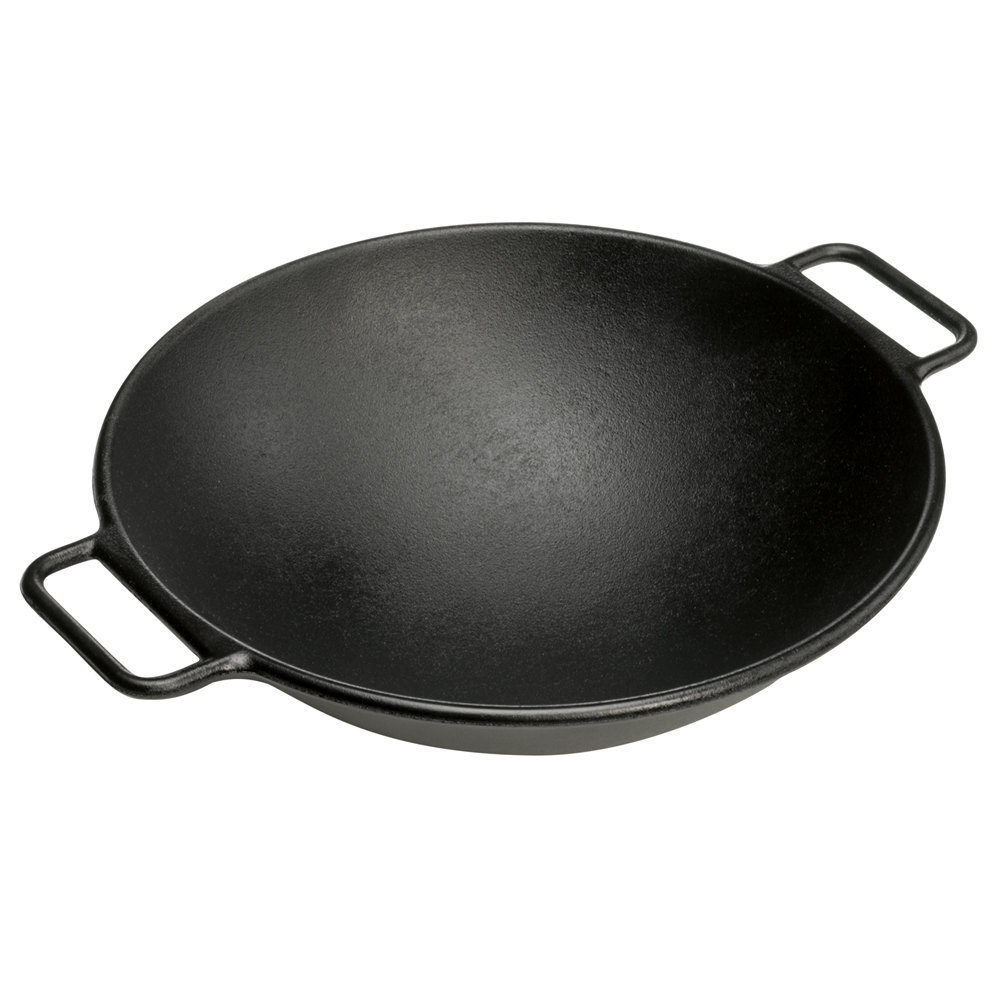Summer is upon us, and you start craving that light, crisp and colorful stir-fry with a characteristic smoky note in the aftertaste. You know, the one that leaves that special someone you cooked it for ask for another helping as her eyes get a little beadier.
The only thing that stands between you and the perfect dinner date is a grocery trip and, well, a wok.
Herein lies your dilemma: your mind conjures up intimidating images of an Asian restaurant cook ably tossing ingredients while just as ably avoiding getting burned by the gargantuan flames erupting from underneath his wok.
You, on the other hand have a regular kitchen with an uninspiring electric stove. Can you stir fry in your kitchen, or should you just order a takeout and hope that your takeout skills are just as impressive on a date?
The good news is that yes, you most definitely can. Moreover, you should!
Before we tell you which woks to consider, however, let’s once and for all decide if you want to get one in the first place. After all, aren’t woks just differently shaped pans, and couldn’t we use a regular Western pan instead?
Well, not if you want the best result.
This has a lot to do with the wok’s spherical shape. According to science, spherical shape has the least surface area per volume and heat transfer is directly proportional to the surface area. In laymen’s words, it means that the dome-shaped wok will take longer to cool off than a relatively flat frying pan. And you need a lot of high temperature to stir fry. A lot!

What makes wok cooking different?
Chinese chefs proudly refer to their art as mastering the wok hei, which poetically means ‘breath of the wok’. Less poetically, the spherical shape of the wok allows for thermal radiation to be highly regulated allowing chefs to control how much heat is applied to food, one batch at a time.
This special shape also means that woks are some of the most versatile kitchen gadgets out there. Indeed, you can steam, stir fry, and even blanche and deep fry in it. In fact, you can make pretty much any Asian takeout dish in your wok, including lo-mein, pad Thai or General Tso’s chicken. The creative possibilities are virtually endless!
This finally gets us to what kind of wok you should be looking for to work well on your electric stove to get the best out of its heat element. The one that has that annoying quality of automatically turning off your burners when they get ‘too hot’. How do you control heat on something like that?
First off, let’s talk about the shape.
In a restaurant situation, heat is applied around the wok: the flame shoots up from below licking at its sides. This is what creates that screeching hot effect heating up the entire wok evenly. To be clear, there is no way any type of stove at home can imitate it.
This is where woks with a flat base come handy. Not only are they able to rest stable on your home stove, they also allow for the heat to gradually spread from the bottom of the wok to its sides. In fact, it is a hybrid between a wok and a regular pan.
Is this an ideal situation? Of course not! But your home never meant to be a perfect carbon copy of a Chinese restaurant to begin with. With all that we said about heat conductivity, flat bottom wok is the best for your home kitchen.
What about the material?
When considering a material that makes a good wok, I simplified all factors for you to only three. You are welcome!
The essential factors are heat conductivity, ease to handle and of course the price. We bet that you care about not overpaying for a fancy kitchen equipment if you have an induction stove. Otherwise, you would have already bought a professional wok set that includes the outdoor propane fire pit.
Researchers point to a handful of materials in use that we can evaluate against the three criteria listed above and that also work well on your induction stove. These are carbon steel, stainless steel, cast iron, and aluminum. Let’s look at them one by one.
Stainless steel.
Stainless steel is an excellent heat conductor and regular, Western pans made of this material have been favored by generations of professional and home chefs alike. However, woks are a different story.
Among few complaints that stainless steel woks receive is the fact that food sticks to it like glue to paper. The reason for this annoying quality is that surfaces made with this material are covered by gazillions of tiny pores that clinch when the steel molecules expand as high heat is applied. And when clinching, steel molecules grab onto food molecules – very much like a closing fist – causing food to stick, especially when you press proteins into the sides of the wok while stir frying. This problem is solved by seasoning when cooking with other metals (see above), but stainless steel cannot be seasoned as the chrome that it contains prevents carbon from binding with metal surfaces.
Thus, even though there are stainless steel woks that are quite affordable and convenient (they are easy to clean and dishwasher safe), the stickiness of this metal causes many an inexperienced home chef to be disappointed. Our recommendation: better avoid this route unless you are a stainless-steel pro and have a special place for it in your heart! We have heard that this metal’s fan club are a legion.
Cast iron

Cast iron is another excellent heat conductor, and cast-iron cookware is loved by chefs all over the planet. Even though it takes time to heat up – it may take up 5-10 minutes to reach its full capacity on an induction stove – eventually it becomes an untamable Hell’s furnace that sears your food to perfection. The major drawback, however, is that it takes just as long to cool off. Thus, it is difficult to adjust temperature on a fly, a skill absolutely necessary when it comes to stir frying in a wok.
Another major hurdle for using cast iron is that it is much heavier than all other types of woks and skillets. Unless you are a weightlifting champion, it is hard to adroitly toss and flip your tofu and carrots in your cast iron wok. The plus side is that cast iron is fantastic when it comes to forming patina (the non-stick surface that forms on your steel pans after use) and being non-stick.
Cast iron can be surprisingly affordable. This cast iron flat bottom wok is a great examples of an excellent quality, relatively inexpensive wok. As you can see, it come with two short handles (this style of wok is known as Cantonese wok), which is not an issue since moving it about is pretty much out of the question.
They are also quite convenient and versatile as you can use them not only on your top induction stove. They are oven safe as well.
To sum up, we would recommend cast iron flat bottom woks if you love working with this materials and will cook ingredients in batches to compensate for that constant heat factor.
Carbon steel
When it comes to woks, carbon steel woks may be chefs’ all-time-favorite. Not only do carbon steel woks perform extremely well in high heat conditions, they retain heat for a long enough time. This means that dropping and flipping food should not cool your wok down too quickly as long as it is piping hot when you start. It gets 10 out of 10 on the heat conductivity criterion.
Carbon steel woks are also relatively light (especially when compared with such notorious heavy weights as cast iron), which is important because stir frying is about moving your ingredients about. In addition, carbon steel woks improve with use as cooking with carbon steel pans creates patina, which means that food will not stick to your wok.
Lastly, carbon steel is highly affordable. Unless you are looking for an artisanal work of art like this Chinese hand-hammered carbon steel wok, a good wok can range from $50-100.
For example, this carbon steel flat bottom wok specifically made for electric induction is good beginner option and it comes with a bamboo lid and a spatula – both very useful in stir frying, steaming of even boiling.
This Japanese carbon steel flat bottom wok is a bit more advanced, and comes pre-seasoned right to your door step.
If you like your woks to come as natural as it gets, and would rather take the seasoning into your own hands than to leave it to the factory, this Joyce Chen flat bottom wok may be a good choice. They come with easy-to-follow seasoning instructions, and the whole process leaves you feeling as if the resulting dark wok is your own creation. It is truly special!
Overall, we think that carbon steel is a perfect choice for your home wok.
Aluminum
Lastly, a word about a material that is very popular in other countries (China, for example) but does not seem to be the choice material with the majority of wok users in the US. We are talking about very light aluminum woks with nonstick surface.
The great benefit of aluminum is that is much lighter than any of the steel varieties discussed above. This works very well for your everyday situations and for easy handling as they are easy to clean. (They are not dishwasher safe, however, as dishwashing stains aluminum). For wok-style stir frying, however, not so much.
Most aluminum woks like this one that comes with a detachable handle and other pans come with nonstick coating which should be good news. However, the screeching heat required for most of stir-frying cooking it simply does not work. After a few uses on very high heat, most coating will start cracking releasing the toxic elements that give nonstick pans such a bad rap.
Even woks made with stone-based nonstick coating that are non-toxic are still prone to damage at the stir fry appropriate temperatures. Still, if the ease of use is what you are looking for, by all means go for it! Just cook in smaller batches!
Is there anything else?
Finally, if you really want to treat yourself and become a proud owner of something that will last you a life time, check out this hand-hammered masterpiece made by Chinese artisans of pure iron. Taking care of it is as easy as of a carbon steel wok, and it can truly be passed from one generation to the next.
To conclude
Wok cooking is rewarding. Once you master the basic techniques learn a few of your favorite recipes, we promise that it will be a labor of love. So, go ahead, get your 14 inch wok! It is guaranteed to impress those watching you stirring those aromatics as smoke covers you in a cloud and the deafening sizzle makes everyone’s mouth water. Just make sure don’t set off the alarm! I know I have, a few times.


